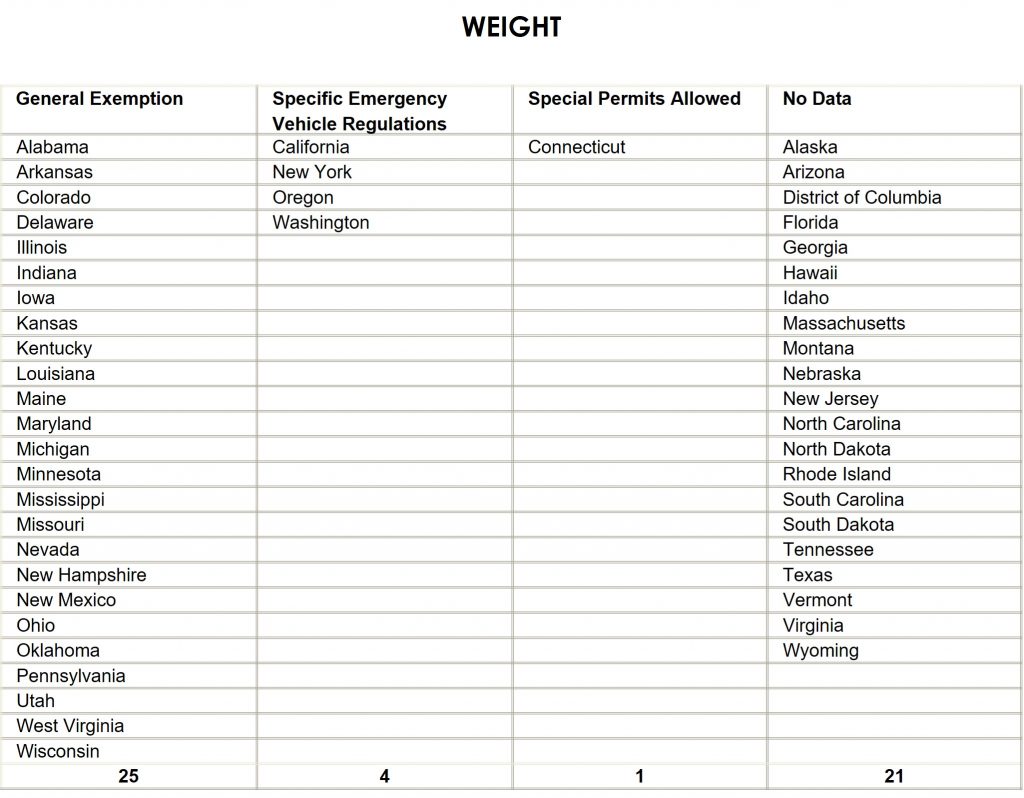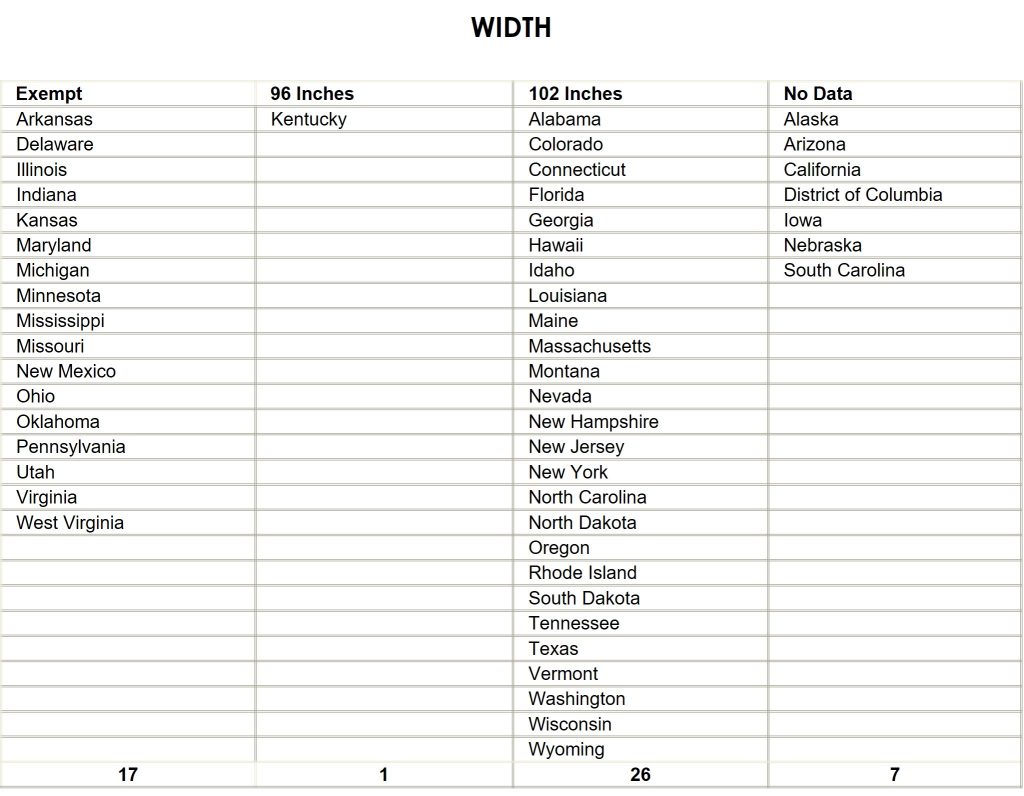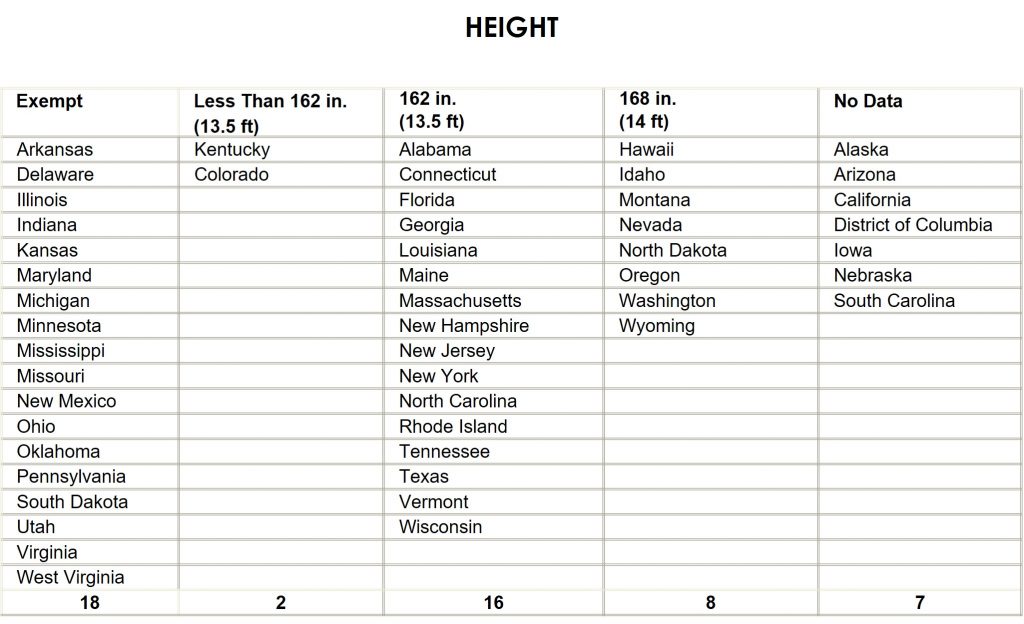PLEASE NOTE: the member portal is under maintenance
Emergency Vehicle Size and Weight Regulation Guideline
Introduction
Emergency vehicles in general, and fire apparatus in particular, are often heavier and larger than typical commercial vehicles. Few people question the need for emergency vehicles, or their axle capacities, when these vehicles show up at the scene of a fire or other emergency. But before they can get to the scene, these vehicles must be moved from their place of manufacture, often crossing through many States, before being delivered to the local department. While most of their miles will be logged within a few miles of the fire station, some emergency vehicles will have the occasion to travel great distances in support of natural disaster relief or to fight wild fires in neighboring counties or States.
Size and weight regulations applicable to emergency vehicles currently vary from one State to the next. Fire Apparatus Manufacturers Association (FAMA) offer this document as a guide to emergency vehicle size and weight laws and regulations.
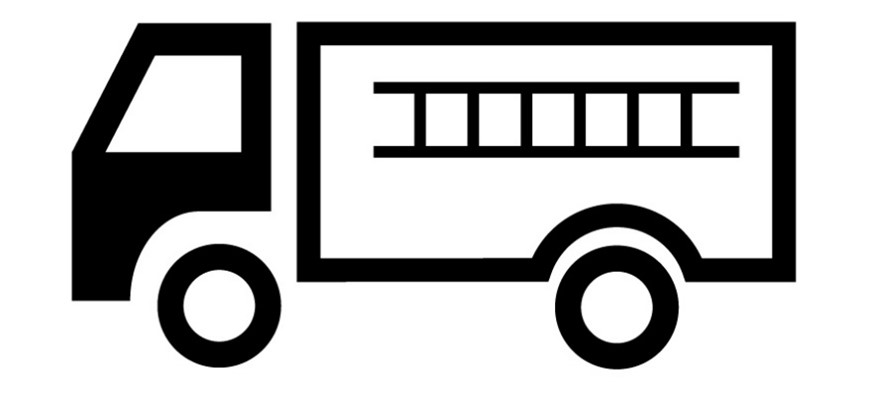
Contents
Emergency Vehicle Size Explanation
Rescues Require Long Ladders
Aerial device horizontal and vertical reach requirements necessitate large vehicles with total mass sufficient to counterbalance the aerial device. These loads could not be made divisible without dramatically increasing the response time as well as the number of personnel required to reassemble the devices at the scene.
Fire Suppression Requires Lots of Water
Fire suppression relies on the ability to deliver water to the scene. Limiting the capacity of tankers and water tenders would increase the response time. Using a greater number of smaller trucks would increase the number of emergency workers required as well as increase vehicle congestion both at the scene, and on the way there.
National Standards Drive Big Axle Capacity
The National Fire Protection Association maintains performance standards that apply to fire apparatus. NFPA 1901 Standard for Automotive Fire Apparatus[1] is adhered to by nearly every fire apparatus purchasing authority in the U.S. This NFPA standard establishes operational and safety criteria for all aspects of fire apparatus including the minimum water, equipment and hose capacity for each type of apparatus. These criteria necessitate the use of high capacity axles. The standard intentionally excludes any reference to vehicle size or weight limitations. Various emergency vehicle configurations and their range of typical sizes and weights are presented in Appendix A.
[1] NFPA 1901 Standard for Automotive Fire Apparatus, 2116 edition.
Federal Regulations
Federal Regulations Allow State Flexibility
Federal truck size and weight regulations are established in 23 CFR Part 658 – Truck Size and Weight, Route Designations – Length, Width and Weight Limitations. This regulation allows States to issue special permits for emergency vehicles as nondivisible loads:
658.5 Definitions
Nondivisible load or vehicle
(1) …nondivisible means any load or vehicle exceeding applicable length or weight limits which, if separated into smaller loads or vehicles, would: (i) Compromise the intended use of the vehicle, i.e., make it unable to perform the function for which it was intended;… (2) A State may treat emergency response vehicles…as nondivisible vehicles or loads.
658.17 Weight.
(h) States may issue special permits without regard to axle, gross, or Federal Bridge Formula requirements for nondivisible vehicles or loads.
The Federal Highway Administration clarifies this further in their “Questions and Answers about Vehicle Size and Weight” website[2]:
- Are some vehicles and articles defined by regulation as nondivisible?
- Yes. States may treat emergency response vehicles, such as firetrucks used to protect persons and property from fires and other disasters that threaten public safety … as nondivisible.
Fire and rescue vehicles would fall within this definition of a nondivisible vehicle since their lifesaving function would be compromised if necessary components (e.g., ladders or hoses) had to be carried on a second vehicle in order to satisfy a weight limitation.
[2] See Federal Highway Administration, Questions and Answers about Vehicle Size and Weight https://ops.fhwa.dot.gov/freight/sw/faqs/qasearch.cfm?q=nondivisible&btnG=Go#SO-124
Interstate Highway Weight Limits for Emergency Vehicles
In October 2015 the U.S. Congress passed the Fixing America’s Surface Transportation (FAST) act. This legislation included special weight limits for emergency vehicles traveling on the Interstate System of highways. This law is contained in U.S. Code Title 23 – Highways:
- 127. Vehicle weight limitations—Interstate System
(r) EMERGENCY VEHICLES.—
(1) IN GENERAL.—Notwithstanding subsection (a), a State shall not enforce against an emergency vehicle a vehicle weight limit (up to a maximum gross vehicle weight of 86,000 pounds) of less than—
(A) 24,000 pounds on a single steering axle;
(B) 33,500 pounds on a single drive axle;
(C) 62,000 pounds on a tandem axle; or
(D) 52,000 pounds on a tandem rear drive steer axle.
(2) EMERGENCY VEHICLE DEFINED.— In this subsection, the term ‘‘emergency vehicle’’ means a vehicle designed to be used under emergency conditions—
(A) to transport personnel and equipment; and
(B) to support the suppression of fires and mitigation of other hazardous situations.
The code also ensures that vehicles that are allowed on Interstate highways must also be allowed access to the highway system.
(b) REASONABLE ACCESS.—No State may enact or enforce any law denying reasonable access to motor vehicles subject to this title to and from the Interstate Highway System to terminals and facilities for food, fuel, repairs, and rest.
This law makes it illegal to prohibit emergency vehicles from traveling on State, County, or Local roads between the interstate system and their terminal destination. Once the vehicle has reached its destination and is no longer in the process of accessing the Interstate System, any State or Local regulations may be enforced.
State Accommodations for Large Emergency Vehicles
Exemptions or Special Regulations
Many State regulations exempt emergency vehicles from vehicle size and weight regulations (See Appendix B). In most other states the regulations are simply not enforced. Some State laws have specific requirements that restrict the size and weight of emergency vehicles, requiring fire departments to obtain one-time or annual over-size or over-weight permits. Before committing to mutual air across states, be sure to check laws for the State(s) you will be traveling through or working in.
Patchwork Regulation May hinder Interoperability.
The Department of Homeland Security in their National Preparedness Guidelines defines the need for planned interoperability. “Preparedness is the responsibility of every level of government, every department, and every agency consistent with its authorities. This includes coordinating preparedness activities among partners operating within their jurisdictional borders, as well as across jurisdictional and geographic borders when dictated by identified threats and risk assessments.”[3] The guidelines stress the need for support across local, state, and tribal boarders. Uniformity among states is particularly important given the specialized operating and design requirements of the relatively small number of emergency vehicles.
State and local governments, with the support of the federal government, are increasingly forming mutual aid agreements that make equipment and personnel available to other states in the event of major emergencies. For example, many emergency vehicles were loaned to the City of New Orleans and other affected regions following Hurricane Katrina, and those vehicles remained in the region during the recovery. Uniform standards are necessary to ensure that emergency vehicles can operate in any state where they happen to be deployed.
[3] National Preparedness Guidelines, Dept. of Homeland Security, Sept 2007, p.3
Emergency Vehicle Road and Bridge Impact
Emergency Vehicle Impact to Roads is Limited.
The average number of miles traveled by any configuration of fire apparatus is less than 5,000 miles per year[4]. This means that the effect of total miles traveled on state and federal roads by these heavy vehicles is minimal.
Local Departments Know their Roads and Bridges.
Fire apparatus operators must be trained to be intimately familiar with the roads and bridges over which they travel. Carry detailed maps of your coverage zone and plan routes from the fire station to each potential emergency scene. Routes should be planned to avoid low over-passes and incompatible bridges. NFPA 1901 Standard for Automotive Fire Apparatus requires a placard in every apparatus that lists the vehicle height and weight in feet and tons to emphasize the importance of watching for bridge and overpass limits.
Fire Industry Emphasis on Road and Bridge Capacity Awareness
In 2013 the Fire Apparatus Manufacturers’ Association began publishing the Fire Apparatus Safety Guide[5]. This guide includes emphasizes the need for fire departments to know their response area, and to survey the road and bridge capacities within their fire protection district and to plan routes accordingly. NFPA 1901 requires every manufacturer to provide a copy of this guide with each new apparatus delivery.[6]
NFPA Standards place Emphasis on Road and Bridge Capacity Awareness
NFPA 1451 Standard for a Fire and Emergency Service Vehicle Operations Training Program requires Fire and Emergency Service Organization (FESO) drivers to be trained in the capacities of the roads and bridges over which they will operate. From the 3-13 edition of NFPA 1451:[7]
6.1 General.
6.1.1 * FESO vehicle drivers/operators shall have a knowledge of applicable federal, state, provincial, and local regulations governing the operation of FESO vehicles.
A.6.1.1 Most motor vehicle laws and regulations are governed by the appropriate state or province; however, there could be certain local ordinances regarding the operation of motor vehicles with which the FESO driver should be familiar. Weight and height restrictions on certain highways, local parking plazas, bridges, and overpasses should be observed.
6.1.2 * FESO vehicle drivers/operators shall become familiar with all applicable U.S. Department of Transportation (DOT) regulations.
6.1.3 * The FESO shall maintain a written policy informing all FESO personnel of the permitted limits governing the operation of FESO vehicles.
[4] Fire Apparatus Duty Cycle White Paper, Fire Apparatus Manufacturers Association, 2004, p. 6
[5] Copies of the Fire Apparatus Safety Guide available at FAMA.org
[6] NFPA 1901 Standard for Automotive Fire Apparatus, 2116 edition, 4.20.2.3(20)
[7] NFPA 1451 Standard for a Fire and Emergency Service Vehicle Operations Training Program, 2013
Ways that State and Local Authorities can Help
Engage with Local Fire Chiefs
History suggests that emergency vehicle axle weights have not proven to be a hazard to U.S. infrastructure. Even so, there may be times when the needs of the fire administration and the highway regulations may be at odds. Permitting authorities and enforcement officials who engage with their local departments prior to equipment acquisition can help the Department to meet the emergency response needs of the community without causing friction with the highway department.
Support Emergency Vehicle Regulation Initiatives
The majority of States already provide size and weight exemptions for emergency vehicles. States that currently do not provide exemptions should consider modifying State codes and regulations to include an emergency vehicle and fire apparatus exemption, or work with their fire protection community to reconcile current practice with State rules. The IAFC and FAMA offer the recommend implementing one of the two following options:
Option 1 – General Exemption
Definition
Emergency Vehicle: A vehicle designed to be used under emergency conditions to transport personnel and equipment, and to support the suppression of fires and mitigation of other hazardous situations.
Size and Weight
The provisions of this code governing vehicle size and weight do not apply to emergency vehicles.
Option 2 – Specific Exemption
Definition
Emergency Vehicle: A vehicle designed to be used under emergency conditions to transport personnel and equipment, and to support the suppression of fires and mitigation of other hazardous situations.
Weight
An emergency vehicle may exceed otherwise applicable vehicle weight limits up to the following maximums:
24,000 pounds on a single steering axle; 33,500 pounds on a single drive axle; 62,000 pounds on a tandem axle; or
52,000 pounds on a tandem rear drive steer axle; and a maximum gross vehicle weight of 86,000 lbs.
Size
An emergency vehicle may exceed otherwise applicable vehicle size limits up to the following maximum values:

Infrastructure Planning
Designers of roads, bridges, subdivisions and other infrastructure projects should consider the size, weight, and capability of the apparatus that will be protecting their district. While appendix A provides general size and weight information on various types of apparatus, infrastructure designers should consult their local fire departments for more specific information on the following apparatus criteria.
- Approach Angle
- Departure Angle
- Breakover Angle
- Turning Circle (wall to wall)
- Turning Circle (curb to curb)
- Aerial Stabilizer Jack Spread
- Aerial Ladder or Platform Vertical and Horizontal Reach
Aerial Stabilizer Loading
Designers of surfaces that need to support an aerial apparatus should account for the loading from the stabilizer jacks. The actual stabilizer pad loading for an aerial device in operation will depend on many factors including tip load, reach, rotation, apparatus weight, and the stabilizer configuration. To determine a general rule of thumb for maximum stabilizer loading value, NFPA 1901 Standard for Automotive Fire Apparatus includes the following requirement:
19.21.4.2 The ground contact area for each stabilizer shall be such that a unit pressure of not greater than 75 psi (500 kPa) will be exerted over the ground contact area when the apparatus is loaded to its maximum in-service weight and the aerial device is carrying its rated capacity in every position permitted by the manufacturer.
Most manufacturers of large aerial apparatus are able to meet this criteria with ground pads that are typically 24 inches square. Contact the fire protection authority in your area for more specific information about the apparatus they operate.
Additional Information
Additional information concerning Federal interstate highway regulations can be found at the Federal Highway Administration Website: https://ops.fhwa.dot.gov/Freight/sw/index.htm
Additional information concerning State highway permitting can be found at individual State oversize and overweight permitting agency websites, or at the American Association of State Highway and Transportation Officials (AASHTO) website: https://www.transportation.org
Appendix A – Typical Fire Apparatus Configurations
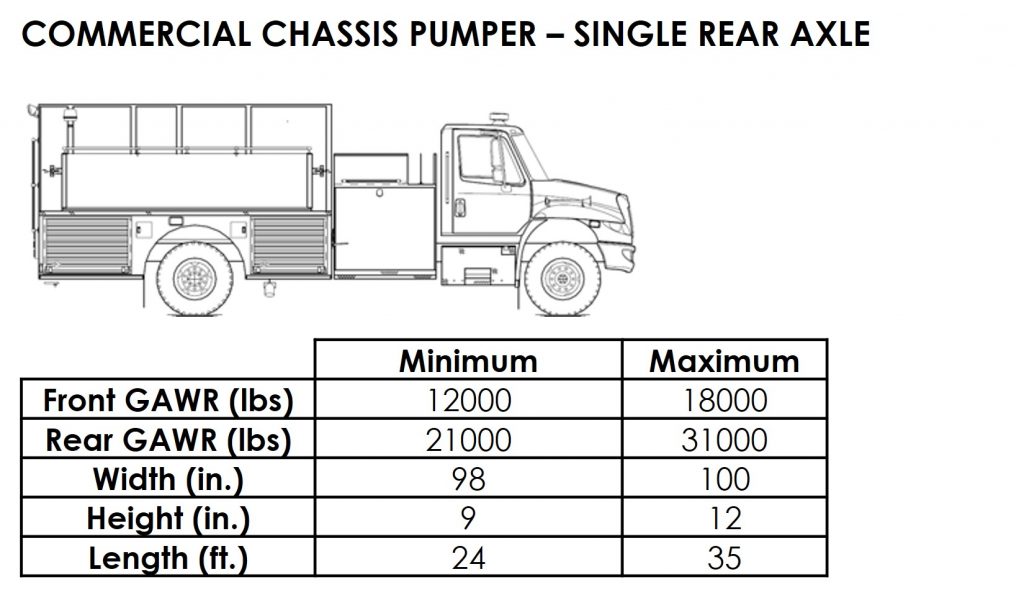
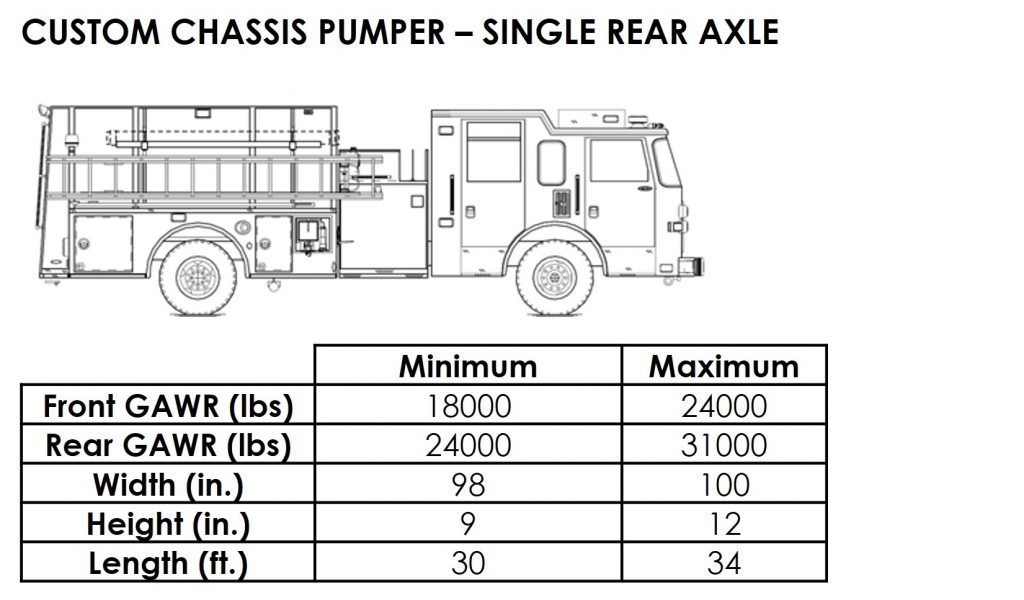
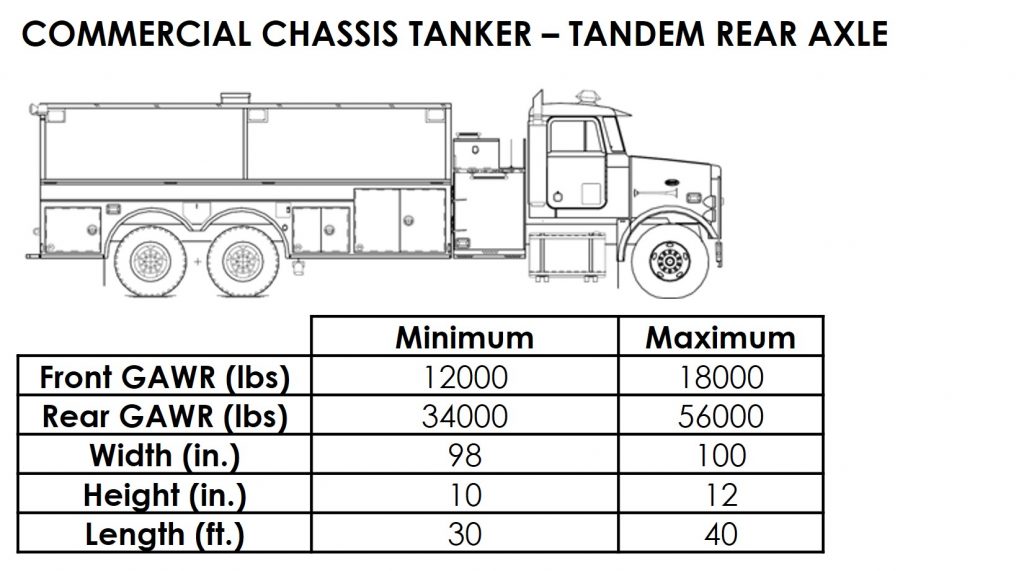
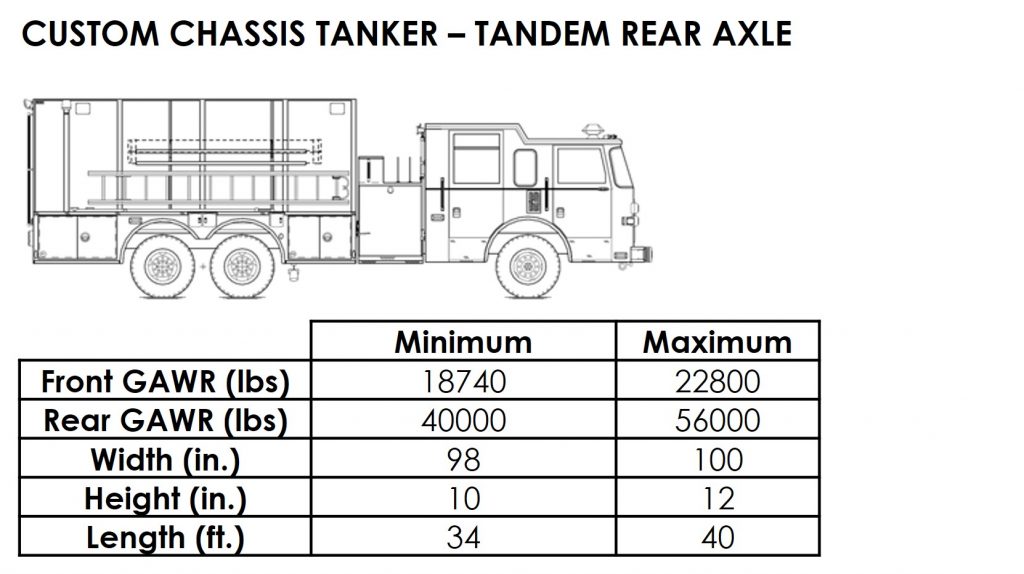
Appendix A – Typical Fire Apparatus Configurations (Continued)
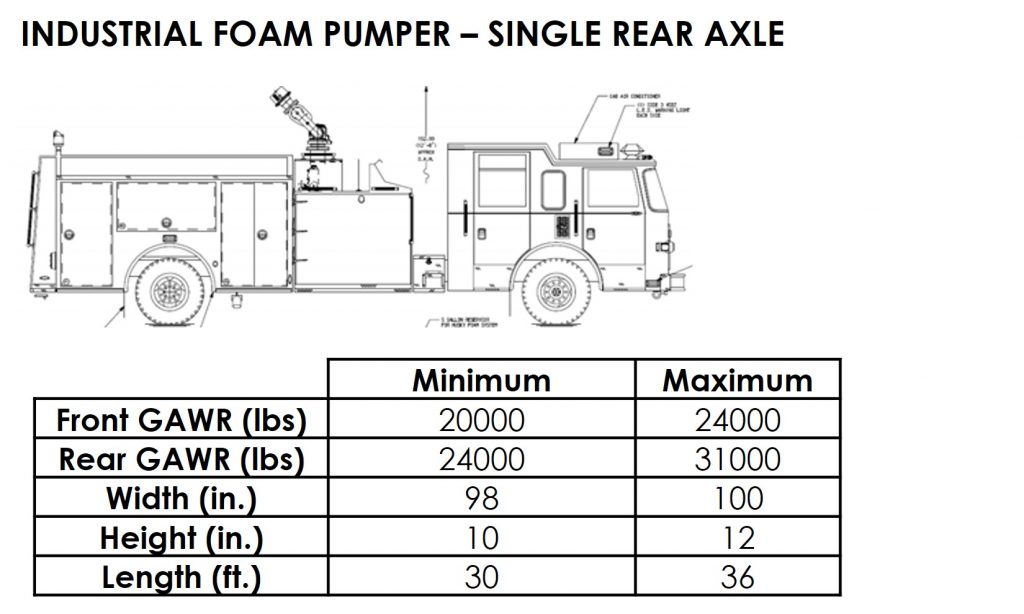
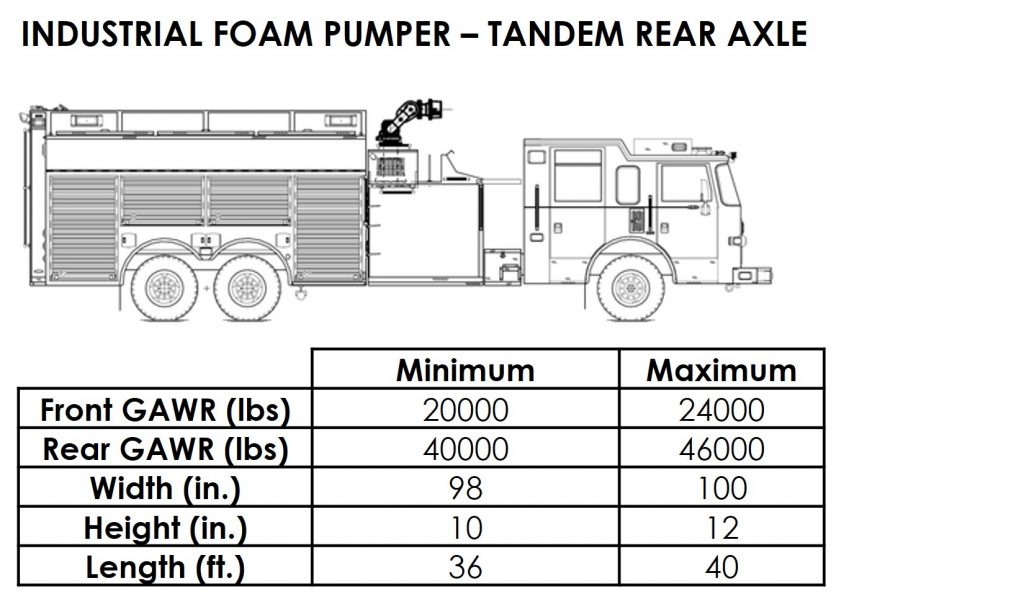
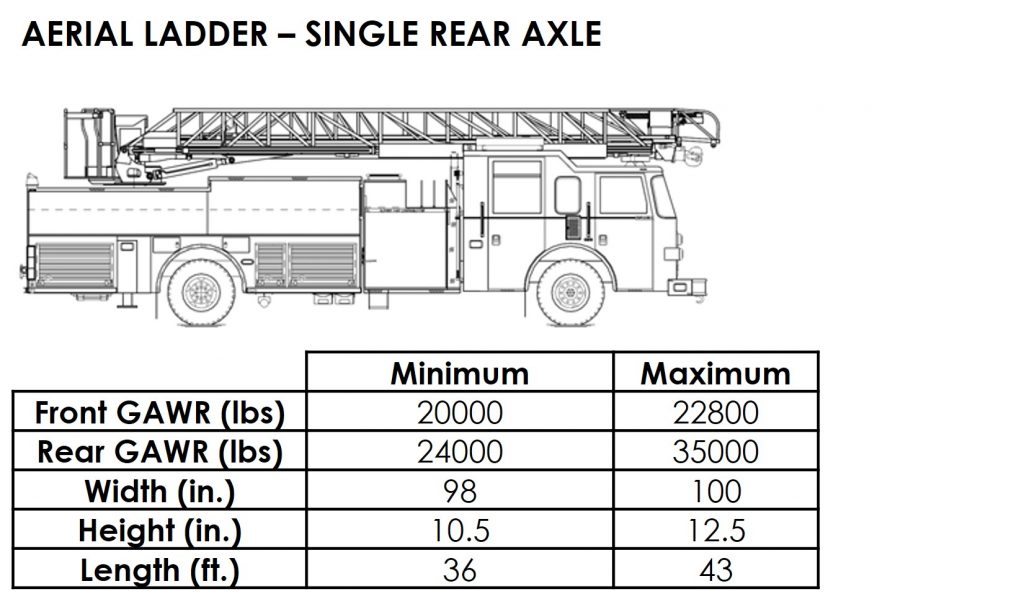
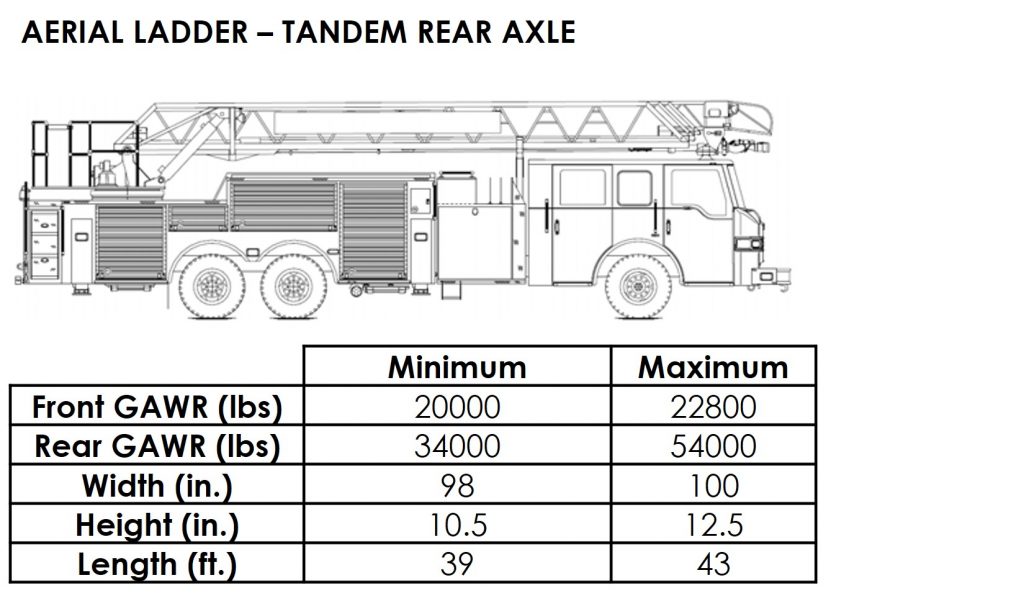
Appendix A – Typical Fire Apparatus Configurations (Continued)
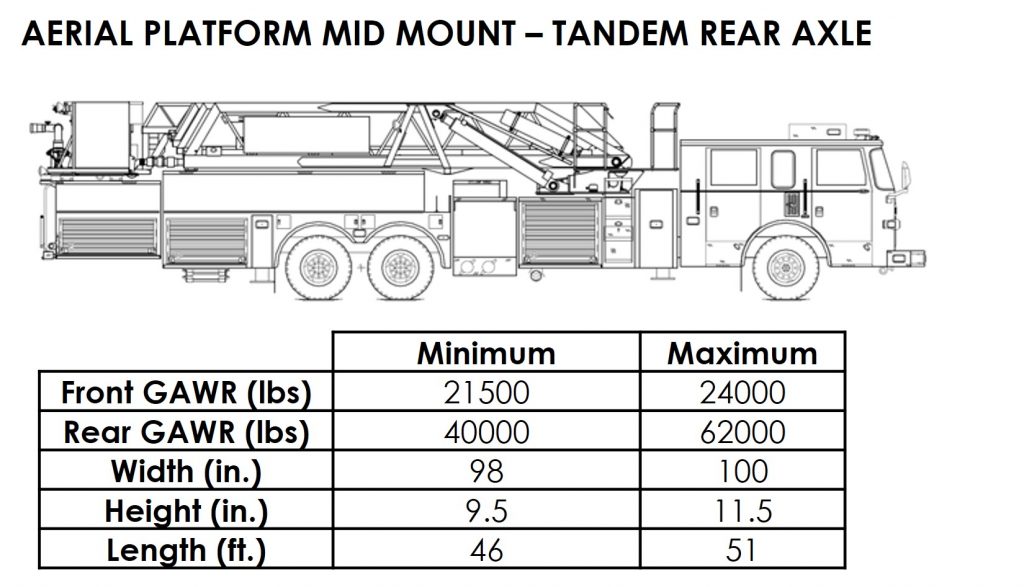
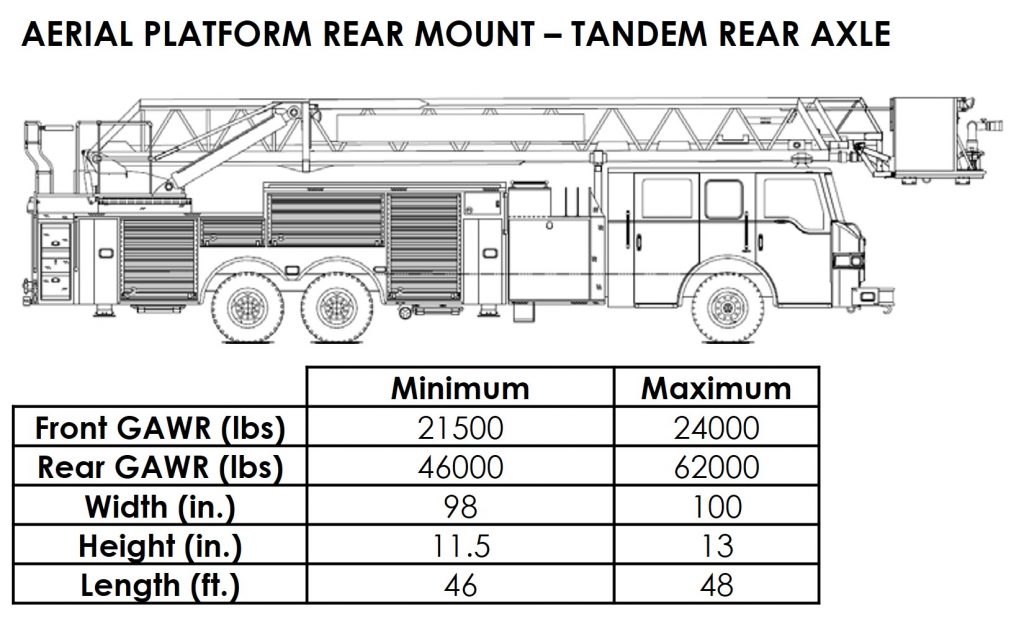
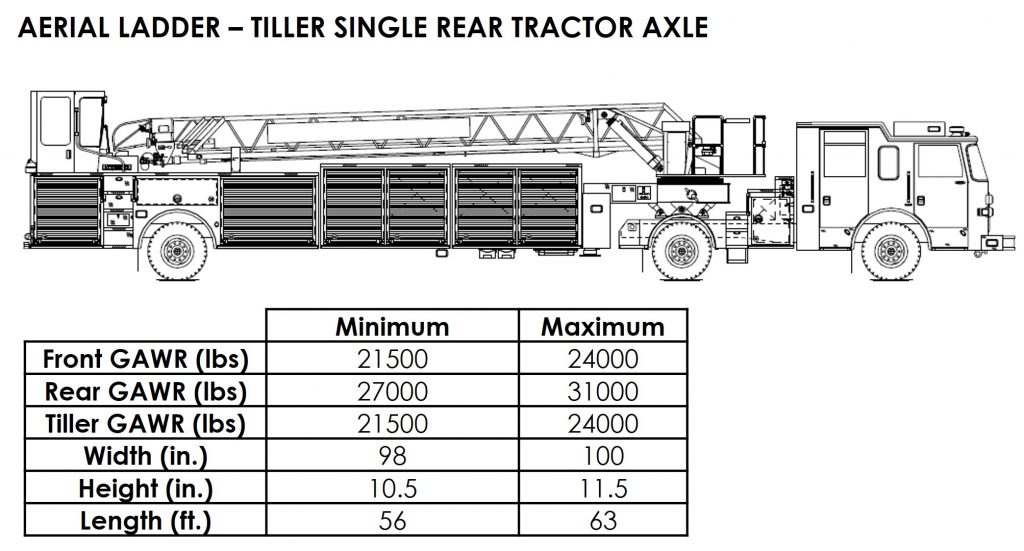
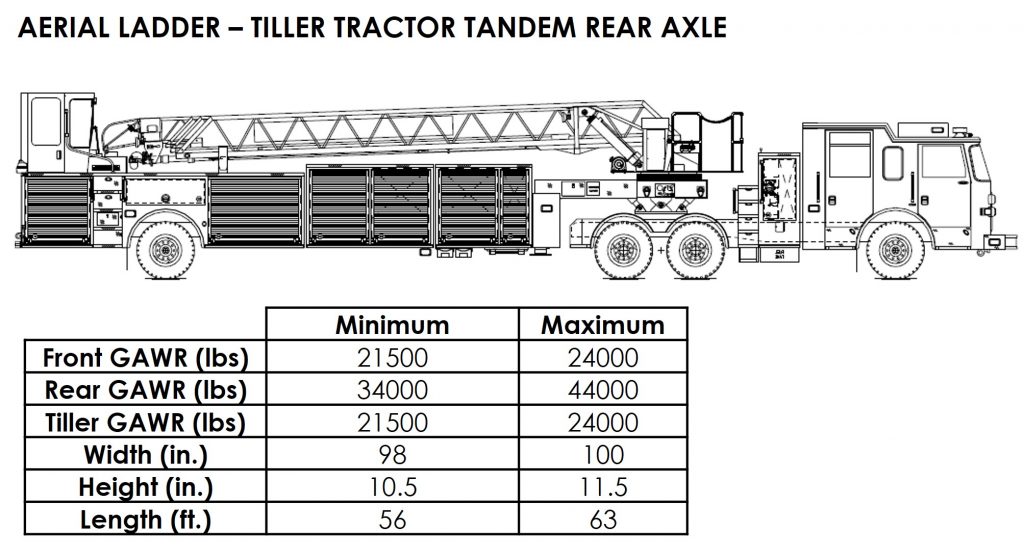
Appendix B – State Fire Apparatus Size and Weight Regulations
